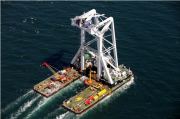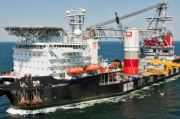
◀ Back to projects overview P201101-013-IHC
Installation methods for use of an underwater noise mitigation screen in conjunction with pile driving from a floating vessel and from a jack-up
Project summary
As a response to the increasing concerns of governments regarding underwater noise during offshore operations, especially pile driving, IHC Merwede developed an underwater Noise Mitigation System (NMS). The system consists of a double walled pipe which is placed around the pile before the pile driving operation.
Pile-driving in Europe is facing restrictions caused by “precautionary regulations” for underwater sound and its effect on the environment. At the moment, anti-noise legislation in The Netherlands prohibits pile-driving from 1 January to 1 July, with a maximum of one offshore wind farm project per year. This limitation during construction increases the cost price for the offshore wind industry. Successful noise mitigation measures during pile-driving may result in a larger installation window per year, as well as achieving the FLOW target of 6000 MW to be installed in 2020 and could potentially reduce costs. Note: At the time of the study the target was 6000 MW to be installed in 2020, last year the target Is set to 4450 MW to be installed in 2023.
This study limits itself to installation methods of the NMS. Fundamental research regarding underwater noise mitigation is outside the scope of this research. However, under the FLOW Program IHC has also carried out part of the development of the technology behind the Noise Mitigation System in FLOW project P201101-001-IHC “Underwater Noise Mitigation During Pile-driving”.
In general the objectives of this study are to reduce the handling time for a NMS and to generate solutions to mitigate the associated cost.
Figure 1 Case specific vessels (Svanen & Pacific Orca)
A desk research was carried out to create an overview of the various handling methods for a NMS during conventional pile driving operations from a specific floating vessel (Svanen heavy lifting vessel), a general heavy lift vessel or from a jack-up barge / vessel. The installation method for heavy lift vessel Svanen was developed by Ballast Nedam Offshore and is described in document 820992-01- ENG-REP-0001. The desk research also involved a study to a universal solution to deploy the NMS from any vessel.
Case specific studies were executed. During this studies virtual cases were elaborated, and specific equipment was designed. Method statements were developed (in 2D and 3D) for three scenarios. The scenarios were elaborated and described in study reports.
For different NMS configurations (Gravity Based, Gripper Supported and Freestanding) the total handling time for deployment and recovery was evaluated from a NMS orientation point of view: vertical, horizontal on deck and horizontal floating starting conditions were considered. Total handling time for every installation method was best when started in vertical position on deck and worst when started from a floating position. Based on this, only vertical starting positions were considered.
For the different types of installation vessels, it was found that the Gripper Supported NMS is the optimum solution when a NMS needs to be deployed from a jackup. A benefit of a Jack-up Gripper Supported NMS is the potential of an optimal ratio between the weight of the NMS and the environmental conditions. Ballast weight can be added for more severe environmental conditions.
Figure 2 NMS-6900 (Project Riffgat)
The Gravity Based NMS is the preferred system for the Svanen installation vessel. A Gripper Supported NMS on the Svanen needs a complicated gripper system due to the vessel motions, so such system is not an obvious solution when the NMS is handled on the Svanen. The handling procedures for a Gravity Based NMS are straightforward, resulting in a simple and fast operation. A Gravity Based NMS is a heavy structure, which is not a problem during the handling of the NMS, contrary to a jackup vessel which is typically limited in its lift capacity.
The Free Standing NMS design is the optimal solution when the NMS is deployed from a general heavy lift vessel. This NMS design is relatively light and it does not require complex grippers to compensate vessel motions. A Free Standing NMS can also be deployed from a jack-up vessel, but a Gripper Supported NMS is the better option for the Jack-up vessel as it uses the benefit of its fixed position relative to the seabed. The handling procedures for the Free Standing NMS are straightforward resulting in a simple operation, but a disadvantage of a Free Standing NMS design is that a vibrating hammer is needed and a part of the piling operation will not be noise protected.
Figure 3 NMS-6900 (Project Riffgat)
In conclusion, the design of a NMS needs to be "custom designed" for every specific case and type of vessel intended or available for installation operations.
Background
IHC Hydrohammer® has carried out various pilot pile-driving tests to scale in the last year and taken measurements relating to underwater noise. From these tests, a noise mitigation screen (NMS) has been designed in close cooperation with IHC Offshore Systems, which results in lowering the sound to reasonable levels.
A full scale NMS (NMS-6900) was used for the successful installation of 30 foundations for the Riffgat offshore wind farm within the German restriction for underwater noise, i.e. 160 dB re 1μPa²s at 750m.
The NMS has been successful and this will give the industry ample opportunities to research and design the best support structures for the offshore wind turbines, including piled solutions, such as monopiles, jackets, tripiles, tripods and so on, in which the industry is not limited to Gravity Based Structures or floating units. This should boost the capacity of installing wind turbines in Dutch waters and make it possible to meet the 2020 target. The information should be used by the industry to extend the pile-driving season. This will reduce the costs of offshore wind development in The Netherlands. The estimated potential cost reduction would range between 0.66% and 0.81% if the limitations are made more flexible by using this system.
Presentation
![]() Windkracht 14: IHC Offshore Tools
Windkracht 14: IHC Offshore Tools
Partners involved
- Ballast Nedam
- IHC
Contact details
Mr. Richard Agema
Project documents




 Share this page
Share this page
